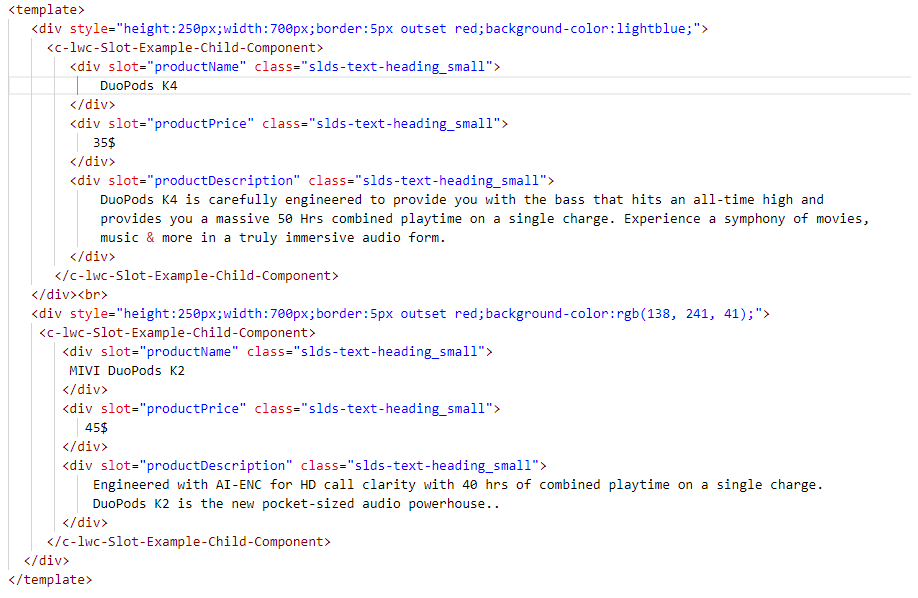LWC slots are a powerful feature that allows components to receive, display, and interact with dynamic content from their parent components. In essence, slots act as placeholders within the child component’s markup where the parent can inject custom content when using the child component. This dynamic content injection enables a higher level of flexibility and reusability, as the same child component can be utilized in different contexts with varying content.
By leveraging slots, developers can build more adaptable and customizable components that seamlessly integrate into diverse scenarios without the need for extensive modifications. This composability fosters a modular and maintainable approach to web development, as components can be combined and interchanged efficiently, promoting code reuse, and streamlining the development process. With Lightning Web Component slots, developers have a robust tool at their disposal for constructing rich, interactive user interfaces that can be tailored to suit various use cases while adhering to best practices in web development.
Light LWC Slot Features
- Dynamic Content Injection: LWC slots enable components to accept and display dynamic content provided by their parent components. This content injection allows for a high level of flexibility, as the same child component can be used in different contexts with varying content.
- Component Composition: Slots facilitate component composition, allowing developers to build complex UIs by combining smaller, self-contained components. This promotes modular development and code reusability.
- Encapsulation: By using slots, the child component does not need to know the specific content it will receive from the parent. It focuses on rendering the provided content without being tightly coupled to its parent’s structure, leading to better encapsulation and more maintainable code.
- Customization: LWC slots allow for customization of components at the parent level. Developers can pass different content, configurations, or styles to the child component via slots, tailoring its behavior and appearance as needed.
- Seamless Integration: Using slots, you can seamlessly integrate multiple components and leverage their combined functionality within a single container, simplifying the overall application architecture.
- Clean and Readable Markup: By breaking down complex layouts into smaller, more manageable components with slots, the markup remains clean and readable, making it easier to understand and maintain.
- Better Developer Experience: LWC slots enhance the developer experience by promoting component reusability and reducing the need for redundant code. They encourage a modular approach to development, leading to more efficient and faster development cycles.
LWC-Slot: An Example
Now, let’s examine a straightforward example that demonstrates the functioning LWC-Slot within an LWC component.
Parent component(lwcSlotExampleParentComponent):

Child Component(lwcSlotExampleChildComponent)

Limitations of Light Slot in LWC
Limited Browser Support: LWC slots are relatively new, and not all browsers may support them. Although major modern browsers generally support slots, it’s essential to consider the browser compatibility of your target audience.
- Slot Distribution: When using slots, the parent component decides what content to pass into the slots. This means that the child component doesn’t have control over the structure or order of the content it receives, which may limit its customization options.
- No Conditional Rendering: LWC slots do not provide built-in support for conditional rendering of content based on specific conditions. This can make it challenging to handle different scenarios where certain content should be displayed or hidden based on runtime conditions.
- Single Slot Limitation: LWC currently supports only a single default slot per component. This means that all dynamic content injection must be handled through this single slot, potentially leading to more complex component structures when dealing with multiple pieces of dynamic content.
- Slot Content Validation: LWC does not enforce strict validation on the content passed through slots. It is the responsibility of the developer to ensure that the content provided by the parent component matches the expected format and data type within the child component.
- Limited Slot Nesting: While you can nest slots in some situations, LWC does not support nested slots as comprehensively as other frameworks. This may restrict the degree of complexity you can achieve with deeply nested components.
- Slower Performance with Large Content: Using slots to pass large amounts of content can result in slower rendering performance, especially when dealing with complex components with extensive data bindings.
Conclusion
Furthermore, the use of slots fosters component reusability, as it enables the same child component to adapt to various parent components by accepting different content and configurations. This promotes a modular development approach, where developers can build smaller, self-contained components that can be combined to create more complex and feature-rich user interfaces.
In data-driven scenarios, slots allow for seamless data propagation from the parent to the child component, ensuring that the child component always reflects the most up-to-date information without tightly coupling it to the parent’s internal data structure. This loose coupling enhances the maintainability and extensibility of the codebase, making it easier to update and expand the application over time.
In summary, slots in Lightning Web Components empower developers to build versatile, reusable, and data-driven components that contribute to more efficient development processes and user-friendly applications. Their ability to customize and compose components makes them a valuable tool for creating sophisticated and adaptable user interfaces in the Lightning framework.
Leave A Comment